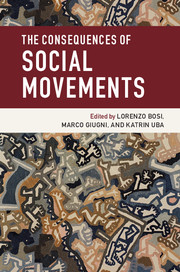Book contents
- Frontmatter
- Contents
- List of figures
- List of tables
- List of contributors
- Introduction
- Part I People
- Part II Policies
- Part III Institutions
- 11 The impact of social movements on political parties
- 12 Watershed events and changes in public order management systems: organizational adaptation as a social movement outcome
- 13 The institutionalization processes of a neo-Nazi movement party: securing social movement outcomes
- 14 Incorporation and democratization: the long-term process of institutionalization of the Northern Ireland Civil Rights Movement
- Conclusion
- Index
- References
13 - The institutionalization processes of a neo-Nazi movement party: securing social movement outcomes
from Part III - Institutions
Published online by Cambridge University Press: 05 January 2016
- Frontmatter
- Contents
- List of figures
- List of tables
- List of contributors
- Introduction
- Part I People
- Part II Policies
- Part III Institutions
- 11 The impact of social movements on political parties
- 12 Watershed events and changes in public order management systems: organizational adaptation as a social movement outcome
- 13 The institutionalization processes of a neo-Nazi movement party: securing social movement outcomes
- 14 Incorporation and democratization: the long-term process of institutionalization of the Northern Ireland Civil Rights Movement
- Conclusion
- Index
- References
Summary
Rudolf Heberle (1949) early on maintained that “as a rule, a major social movement tends to form its own political party or at least to affiliate itself with an existing party” (p. 352). However, since Heberle's observation, the relationship between social movements and political parties has been relatively neglected. Doug McAdam and Sidney Tarrow (2010) have in a recent article expressed their concern that the field of social movement research “had become excessively ‘movement centric’” (p. 529) giving far too little attention to the relationships between social movements and political parties. In this chapter I address this lacuna by forging a bridge between the literature on social movement institutionalization processes and that on political party institutionalization processes to analyze the Swedish neo-Nazi movement institutionalization in a political party, the Sweden Democrats. In 1989 the Sweden Democrats, at that time a rather obscure sect within the Swedish neo-Nazi movement, was formed as a political party. In 2010 the party successfully mobilized voters and entered the Swedish parliament with 5.7% of the vote in the national election and 612 seats in the municipal councils. In the 2014 election to the European Parliament the party garnered 9.7% of the vote and in the elections to the Swedish Parliament later the same year, SD more than doubled their electoral support mobilizing 12.9% of the vote.
The party building of the Sweden Democrats was a strategic action taken by the neo-Nazi movement to advance their political goals. Thwarted by the political party system in Sweden and without elite allies the movement actively chose to pursue politics in the electoral arena in order to enter policy-making bodies to effect political outcomes. This social movement strategy – forming a “movement party” as the partisan arm of the movement (Keuchler and Dalton 1990; McAdam and Tarrow 2010; Maguire 1995 introduces the notion of “party of movement”) – brings with it inherent dilemmas (Bomberg 1992) in that for the strategy to be successful the movement party must undergo processes of institutionalization. That means that, “no matter how radical their goals, these political challengers are prepared to work within the system because they see government office as the most direct way of achieving their objectives” (Schwartz 2000: 456).
- Type
- Chapter
- Information
- The Consequences of Social Movements , pp. 314 - 337Publisher: Cambridge University PressPrint publication year: 2016
References
- 11
- Cited by



